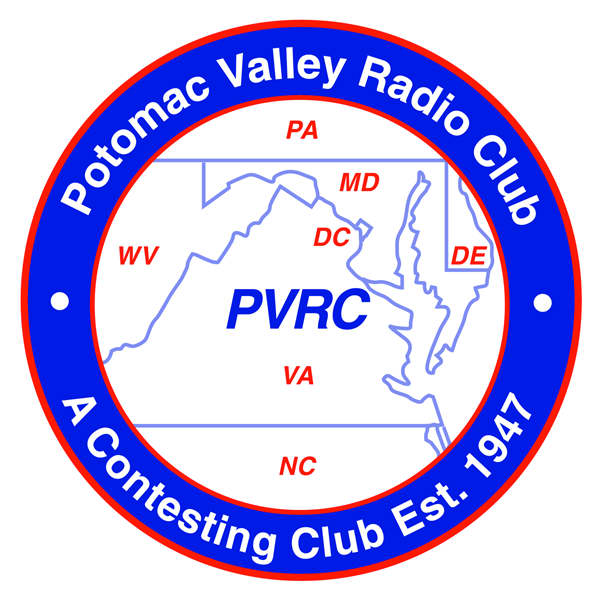
Station Construction
Part III - The "Un-Beezer" Trench & Grounding
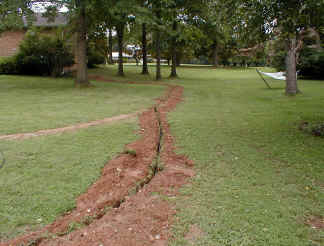
Another visit to the rental place produced a medium sized ditch witch trencher, which I trailered home.
Then K1DQV and I ran the beast from each tower to the house. Again we hit rocks, and the ditch witch was amazing that it could yank four or five inch rocks out of the trench and throw them aside.
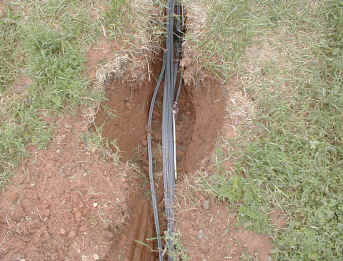
So I chose direct burial type of cables. UF Romex was used for the rotor and stackmatch control cables, and Andrew LDF Heliax was used for the feedlines.
UF Romex is a great choice for rotor cables. It is cheap, and can be directly buried. Two runs of romes provide six wires, and the motor start capacitors were relocated to the junction box at the base of the tower to avoid the need for the 7th and 8th wire. Ring rotors run on DC and have no brake, so they only need five wires. A total of 18 runs of UF romex were run to the towers, ten to the first tower, and eight to the second. Two romex runs per rotor and stackmatch, plus some spares.
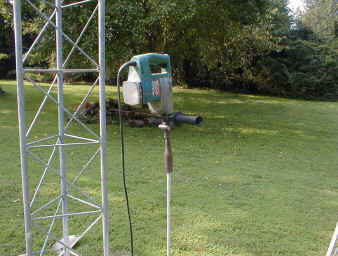
Ten ground rods were pounded in using a hammer drill with the proper attachment to pound ground rods. When the ground rods hit a rock, a sledge hammer was used to crack the rock so the hammer drill could continue it's work
All the ground rods were cadwelded to the ground wire in the trench. Galvanized ground rods were used to minimize and galvanic corrosion, copper ground rods are just a little too reactive.
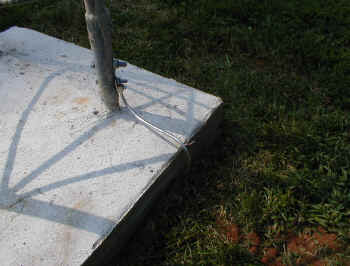
Do not cadweld to a tubular leg tower - there is a slight possibility the cadweld might burn through the leg.
Only compression lugs should be used with solid wire, so they can be periodically tightened if needed. Do not use crimp-on lugs with solid wire. They are fine for stranded wire.
The #2 ground wire was brought back to the house, and attached to the house ground at the panel box. That way, the entire grounding system has a chance to remain at the same potential during a lightning strike and minimize damage to the equipment. You might think that this would bring lightning in to the house from the towers, but remember it has to go by several ground rods before it gets to the house.
The ground system was measured using a commercial ground tester, and the impedance was measured at 1.5 ohms, which is a VERY good ground. You can see the impedance drop every time an additional ground was added. A single ground rod has an impedance somewhere around 30 ohms if you are lucky, so it is a must to have many ground rods tied together with a large size conductor to achieve a good ground. A good ground is usually defined as 5 ohms or less.

Tower #1 required five 450 foot runs of 1/2" LDF cable.
Tower #2 required five 280 foot runs of 1/2" LDF, and four 280 foot runs of 7/8" LDF for the higher VHF bands.
The upper connectors were put on all the cables, and Brian, N3ST went up the towers while I hoisted the cables up. He then dressed all the feedlines down the towers, and we stuffed them into the trench.
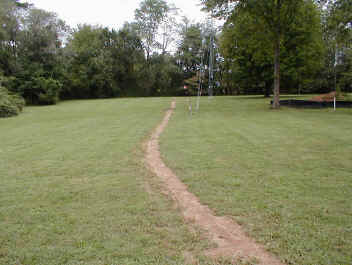
I planted grass seed over the trench, and within a couple weeks the lawn was completely restored, making my wife happy.
Oh, by the way, the reason I call it the "un-beezer" trench is that most guys take forever to fill in their trench, including the Beezer, Bob W2BZR. Mine was all done within a week!
The complete tower installation was done by the end of August, and the lower antennas and stack matches were done by the end of September. The 80 meter wire yagi was completed at the end of December, so all my friends and I really moved along here and constructed a pretty good station in just a couple months!
Future plans include adding 2304 and 10ghz to the VHF station (completed in May 2004), improving the 160 meter antennas, and adding a third tribander to the stack at 32 feet.
Here is a list of hams that helped construct the station: Charlie KA3IWP, Bob W9GE, Roger K1DQV, Brian N3ST, Bill N3RR, Tony K3WX. Frank W3LPL provided invaluable design assistance, and Norm W3NRS (now W4NRS) provided the tower services and crane. Maurice KA3EJJ machined the custom thrust bushings for the tower tops. Thanks to all that helped, no way I could have done this by myself. Even my wife Terry pitched in and helped me fill the trench.
CU in the pileups!
Brian, N3OC